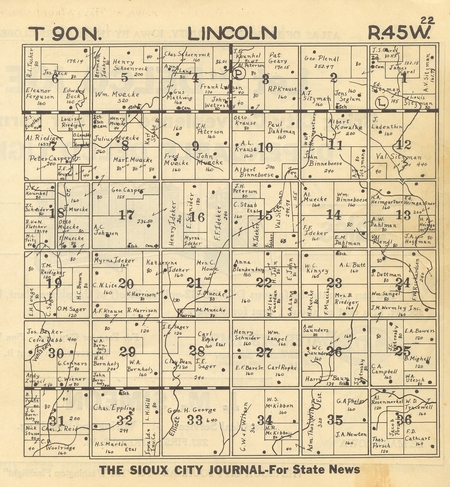LeMars Sentinel
May 15, 1891
PIONEER DAYS IN PLYMOUTH COUNTY
An Historic Account Of The Early Settlement, Organization, and
Subsequent Development of the County by Townships
Interesting Reminiscences, Adventures, Amusing Incidents and the
Hardships Connected with the County's History from 1856 to 1891,
Including the "Homestead" and "Grasshopper" Days.
By W. L. Clark
Chapter XII.
LINCOLN TOWNSHIP
Descriptive-Population-Early Settlement-Coming of the Illinois Central
Railway-Schools and Churches
Township ninety, range forty-five is known as Lincoln civil township,
but formerly was embraced in Plymouth. It is located on the south line
of the county, with Elkhorn township on the east, Stanton on the north
and Hungerford on the west. It was organized October 3, 1860, one of
the first in Plymouth county. The whole territory is exceedingly well
provided with water-courses and natural drainage. Muddy creek is in the
central part of the township. Dry Branch, of Muddy creek, courses its
way through the eastern part of the township, while Big Whisky is found
in the western part of the territory.
This is one of the best agricultural townships in Northwestern Iowa.
The population in 1885 was 669, of this number 500 were American born,
and the remained are chiefly German. The last census shows but a slight
increase in population there now being 679 within the township, but
there has been much improvement in way of development of farms, but hose
who have taken the place of some of the first settlers.
PIONEER SETTLERS
The first man to enter this fair domain and build for himself a home,
was Hon. William Barrett, whose name was for many years well known in
Plymouth county, from the fact of his serving as the chairman of the
board of supervisors for so long a period. He had previously lived in
Hungerford township, but after a short residence there he took up a
homestead on section eight of Lincoln, where he remained until 1885-86,
when he removed to Dakota territory, now South Dakota.
T. J. Rea (son of A.E. Rea, for many years a county officer here)
homesteaded land on the northwest quarter of section eight, about they
year 1866. He finally sold and removed to Kansas.
The Mathwig family were among the first to settle in Lincoln, along the
northern line. They came in just after the Rebellion closed. The
father died in 1887. Two sons are still residents of the township.
But little settlement was made from that date on to the time the
Illinois Central Railroad was built through the county in 1869-70. Much
attention has been paid to school matters, and by the school
superintendent's report of October, 1889, it is found that Lincoln
township had six sub-districts, each provided with a suitable
school-house. The total scholarship, at that time was 168. There is a
Roman Catholic church known as St. Joseph's.
A German Lutheran organization is found in the western portion of
Lincoln twp, with a building on section eight. The influence of the
faith held by German Lutherans is indeed great. |
